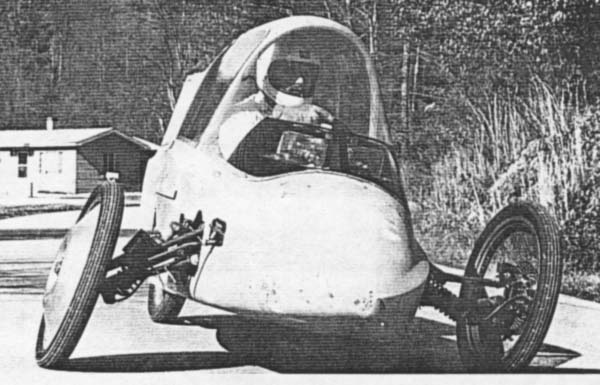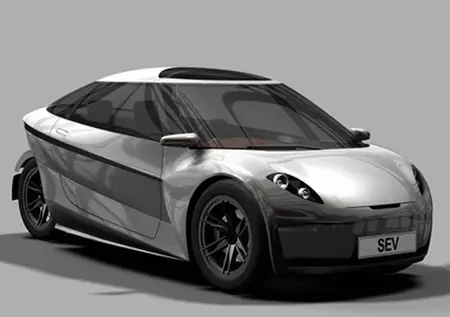The choice for a rather narrow and sleek vehicle is obvious - the gain is immense: low drag coupled to lightweight and structural rigidity. Plus sleekness forms a perfect match for self-driving. Passenger safety aspect has been covered: simple, change the vehicle's seating layout. Contrary to what's standard, the driver is seated to the right in the EU and the U.S., and to the left in countries like the U.K. Added benefit: heads cannot slam onto each other when the vehicle is broad-sided.
Consequently, a sleek vehicle needs to bank in order to take corners and bends safely. On picture 4 below you see how a car tends to roll outward when cornering. With tilt (lean into the corner), ForThree enables you to experience the sort of fun motorcyclists are used to (picture 3). Hence, a triangle-shaped platform is inherently more resistant to tipping over than a rectangular platform. The subsequent tapered rear-end is conducive to low drag.
The choice for a protruding rear wheel(s) assembly is obvious too. Firstly, it allows for a long wheelbase, which directly translates to comfort. Secondly, if rear bumper and subsequent frame attachment are constructed separately from the rear wheel(s) suspension itself, you create a solid rear-impact protection. It actually uses (invades) the front crumple zone of the oncoming car to dissipate crash energy.
The choice for a protruding rear wheel(s) assembly is obvious too. Firstly, it allows for a long wheelbase, which directly translates to comfort. Secondly, if rear bumper and subsequent frame attachment are constructed separately from the rear wheel(s) suspension itself, you create a solid rear-impact protection. It actually uses (invades) the front crumple zone of the oncoming car to dissipate crash energy.
 There are a couple of ways to make it bank when 'taking the twisties'. Usually it is a mix of variable wheel geometry causing the vehicle to roll upon steer input (lift on the outside and dip on the inside), active dampers and/or hydraulic actuators, speed measuring and G-force sensoring. With today's powerful computers, all variables can be fed into the equation, to find out what works best before actually testing prototypes. Doable? Oh yes. The rear-wheel steered Toyota i-Road already proved that tilt can be achieved with a much more challenging platform (shorter as well as narrower). More info .
There are a couple of ways to make it bank when 'taking the twisties'. Usually it is a mix of variable wheel geometry causing the vehicle to roll upon steer input (lift on the outside and dip on the inside), active dampers and/or hydraulic actuators, speed measuring and G-force sensoring. With today's powerful computers, all variables can be fed into the equation, to find out what works best before actually testing prototypes. Doable? Oh yes. The rear-wheel steered Toyota i-Road already proved that tilt can be achieved with a much more challenging platform (shorter as well as narrower). More info .
What's to decide? Tandem rear wheels or one big rear wheel. Twin wheels are more resistant to hydroplaning and side-sweeping the rear end. All four wheels can be 'one-size fits all'. Even better, a driver might continue his journey if a rear tire gets deflated. It may be more difficult and costly to engineer though. One big motorcycle-type rear tire is less complex; the only thing is that the rear bumper+frame attachment will run bracket-like on both sides of the rear wheel, instead of hidden between the two wheels (which looks nicer).
Ralph Panhuyzen, sevehicle@gmail.com Ph. ++31 61 743 4661
Ralph Panhuyzen, sevehicle@gmail.com Ph. ++31 61 743 4661
Automotive experts already acknowledged the 'outside the (car) box' vehicle described/depicted here as a viable alternative, and doable to engineer. Auctor intellectualis (and IP holder) Ralph Panhuyzen was involved with the scientific study on car mobility (ISBN-13: 978-90-442-0015-7) in the Netherlands (one of the most densely populated countries in the world) which was held under the auspices of the NWO, the Netherlands Organization for Scientific Research. NB: this presentation is put together for assessment and publicity purposes only. Unauthorized use forbidden. The New Isetta aka Smart ForThree is not an open source project, and formally OHIM registered. If in doubt about the semantics of what is "authorized" (literally: of, by or from the author) and what is not (presenting or using what has been created by someone else as if it were yours) consult a legal expert.



I just discovered this blog. I will be reading current and past blogs.This post is Great. Thanks you for this. Can I share for my website
ReplyDeletetop modular kitchen trolly supplier in pune